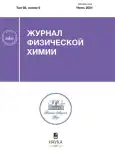Моделирование переноса излучения в ближнем ИК-диапазоне и определение содержания метана в атмосфере с использованием различных спектроскопических баз данных
- Autores: Чеснокова Т.Ю.1, Ченцов А.В.1, Грибанов К.Г.2, Задворных И.В.2, Захаров В.И.2,3
-
Afiliações:
- Институт оптики атмосферы им. В. Е. Зуева СО РАН
- Уральский федеральный университет
- Институт математики и механики им. Н. Н.Красовского УрО РАН
- Edição: Volume 98, Nº 6 (2024)
- Páginas: 25-33
- Seção: ЭКСПЕРИМЕНТАЛЬНАЯ И ТЕОРЕТИЧЕСКАЯ СПЕКТРОСКОПИЯ ГАЗОВОЙ ФАЗЫ
- ##submission.dateSubmitted##: 27.02.2025
- ##submission.datePublished##: 29.12.2024
- URL: https://innoscience.ru/0044-4537/article/view/668945
- DOI: https://doi.org/10.31857/S0044453724060054
- EDN: https://elibrary.ru/PYGQJO
- ID: 668945
Citar
Texto integral
Resumo
Проведено моделирование атмосферных солнечных спектров в полосах поглощения метана в ближнем ИК-диапазоне и сделано сравнение со спектрами, измеренными на наземном фурье-спектрометре с высоким спектральным разрешением в различных атмосферных условиях. Определено содержание метана в столбе атмосферы с использованием различных версий спектроскопических баз данных HITRAN (2008, 2012, 2016, 2020), GEISA (2015, 2020) и ATM (2016, 2020) и банка линий CH4 GOSAT2014. Для каждой спектроскопической базы было рассчитано усредненное по 1346 спектрам значение RMS (отклонение рассчитанных спектров от измеренных). Было обнаружено, что наименьшее значение RMS наблюдалось для результатов, полученных с линиями поглощения CH4 из ATM2020, ATM2016 и HITRAN2008. Были выявлены параметры линий поглощения СН4 в спектроскопических базах данных, которые вносят наибольшую погрешность в моделирование переноса излучения в атмосфере в спектральном диапазоне 6000–6100 см–1.
Palavras-chave
Texto integral
Sobre autores
Т. Чеснокова
Институт оптики атмосферы им. В. Е. Зуева СО РАН
Autor responsável pela correspondência
Email: ches@iao.ru
Rússia, Томск
А. Ченцов
Институт оптики атмосферы им. В. Е. Зуева СО РАН
Email: ches@iao.ru
Rússia, Томск
К. Грибанов
Уральский федеральный университет
Email: ches@iao.ru
Rússia, Екатеринбург
И. Задворных
Уральский федеральный университет
Email: ches@iao.ru
Rússia, Екатеринбург
В. Захаров
Уральский федеральный университет; Институт математики и механики им. Н. Н.Красовского УрО РАН
Email: ches@iao.ru
Rússia, Екатеринбург; Екатеринбург
Bibliografia
- Masson-Delmotte V., Zhai P., Pirani A. et al. IPCC, 2021: Climate Change 2021: The Physical Science Basis. Contribution of Working Group I to the Sixth Assessment Report of the Intergovernmental Panel on Climate Change. Cambridge University Press, Cambridge, United Kingdom and New York, NY, USA. doi: 10.1017/9781009157896
- Forster P., Ramaswamy V., Artaxo P. et al. 2007: Changes in Atmospheric Constituents and in Radiative Forcing. Climate Change 2007: The Physical Science Basis. Contribution of Working Group I to the Fourth Assessment Report of the Intergovernmental Panel on Climate Change. Chapter 2. Cambridge University Press, Cambridge, United Kingdom and New York, NY, USA.
- Prather M.J., Holmes C.D., Hsu J. // Geophys. Res. Lett. 2012. V. 39. P. L09803. doi: 10.1029/2012GL051440
- Holl G., Walker K.A., Conway S. et al. // Atmos Meas Tech. 2016. V. 9. P. 1961–1980. https://doi.org/10.5194/amt-9-1961-2016
- Василенко И.А., Садовников С.А., Романовский О.А. // Оптика атмосферы и океана. 2020. Т. 33. № 04. С. 298–301. doi: 10.15372/AOO20200408
- Chesnokova T.Yu., Chentsov A.V., Rokotyan N.V. et al. // J. Mol. Spectrosc. 2016. V. 327. P. 171–179. doi: 10.1016/j.jms.2016.07.001
- Chesnokova T.Yu., Makarova M.V., Chentsov A.V. et al. // J. Quant. Spectrosc. Radiat. Transfer. 2020. V. 254. 107187.
- Rothman L.S., Gordon, I.E., Barbe A. et al. // Ibid. 2009. V. 110. P. 533–572.
- Rothman L.S., Gordon I.E., Babikov Y. et al. // Ibid. 2013. V. 130. P. 4–50.
- Gordon I.E., Rothman L.S., Hill C. et al. // Ibid. 2017. V. 203. P. 3–69.
- Gordon I.E., Rothman, L.S., Hargreaves, R.J. et al. // Ibid. 2022. V. 277(10794). P. 1.
- Jacquinet-Husson N., Armante R., Scott N.A. et al. // J. Mol. Spectrosc. 2016. V. 327. P. 31.
- Delahaye T., Armante R., Scott N.A. et al. // J. Mol. Spectrosc. 2021. V. 380. P. 111510. https://doi.org/10.1016/j.jms.2021.111510
- Toon G.C. ATM compilations from Geoffrey Toon (JPL). http://mark4sun.jpl.nasa.gov/toon/linelist/linelist.htm
- Toon G.C., Blavier J.F., Sung K. et al. // J. Quant. Spectrosc. Radiat. Transf. 2016. V. 182. P. 324. https://doi.org/10.1016/j.jqsrt.2016.05.021
- Nikitin A.V., Lyulin O.M., Mikhailenko S.N. et al. // Ibid. 2015. V. 154. P. 63. https://doi.org/10.1016/j.jqsrt.2014.12.003
- Birk M., Wagner G., Loos J. et al. ESA SEOM–IAS – spectroscopic parameters database 2.3 μm region // Technical Report. Scientific Exploitation of Operational Missions – Improved Atmospheric Spectroscopy Databases; 2017. https://doi.org/105281/zenodo1009126
- Nikitin A., Rodina A., Thomas X. et al. // J. Quant. Spectrosc. Radiat. Transfer. 2020. V. 253. P. 107061. https://doi.org/10.1016/j.jqsrt.2020.107061
- Predoi-Cross A., Brawley-Tremblay M., Brown L.R. et al. // J. Mol. Spectrosc. 2006. V. 236. № 2. P. 201. https://doi.org/10.1016/ j.jms.2006.01.013
- Devi V., Benner D.C., Sung K. et al. // J. Quant. Spectrosc. Radiat. Transf. 2016. V. 177. P. 152. https://doi.org/10.1016/j.jqsrt.2015.12.009
- Mitsel A.A., Ptashnik I.V., Firsov K.M. et al. // Atmospheric and Oceanic Optics. 1995. V. 8. № 10. P. 847.
- Anderson G., Clough S., Kneizys F. et al. AFGL Atmospheric Constituent Profiles (0–120 km). Air Force Geophysics Laboratory. AFGL-TR-86-0110. Environmental Research Paper. Hanscom AFB: MA 01736. 1986. № 954. 25 p.
- Gribanov K., Jouzel J., Bastrikov V. et al. // Atmos. Chem. Phys. 2014. V. 14. P. 5943. https://doi.org/10.5194/acp-14-5943-2014
- Kalnay E., Kanamitsu M., Kistler R. et al. The NCEP/NCAR40-year reanalysis project // B. Am. Meteorol. Soc. 1996. V. 77. P. 437.
- http://www.esrl.noaa.gov/psd/data/reanalysis/
- Palm M. Theoretical background SFIT4 / Sfit4 Error Analysis Workshop. 2013.
- Rinsland C.P., Jones N.B., Connor B.J. et al. // J. Geophysical Research. 1998. V. 103. P. 28197. https://doi.org/10.1029/98JD02515
- Armante R., Scott N., Crevoisier C. et al. // J. Quant. Spectrosc. Radiat. Transf. 2016. V. 327. P. 180.
- Rodgers C.D. Inverse Methods for Atmospheric Sounding: Theory and Practice / World Scientific Publishing Co. Pte. Ltd., 2000.
- https://airs.jpl.nasa.gov/
- https://giovanni.gsfc.nasa.gov/
Arquivos suplementares
















